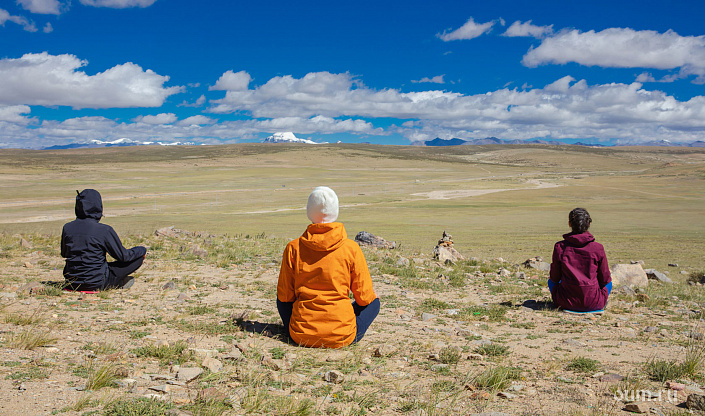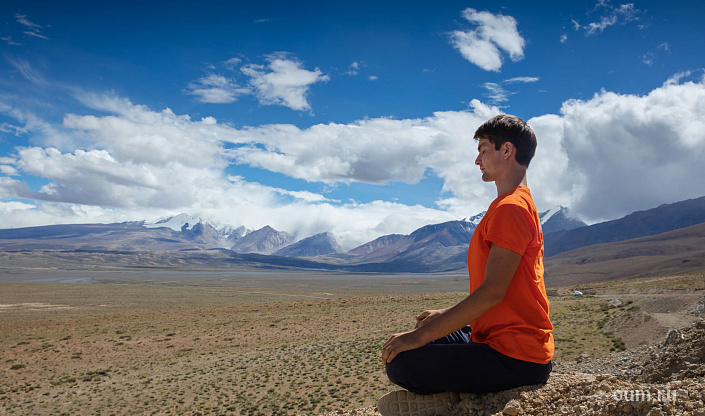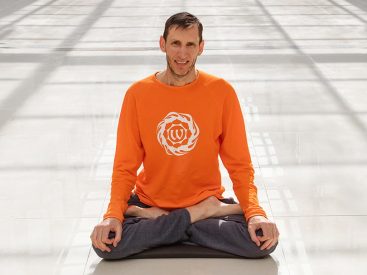“All fears, as well as all boundless suffering originate in the mind,” wrote the philosopher-monk Shantideva in his philosophical treatise. It’s hard to argue with this: it is our restless mind that makes us suffer. Shantideva compares our restless mind to a mad elephant. Indeed, at times, some stuck thought can cause incredible disturbance for months, or even years.
And oddly enough, when we try to practice meditation, at the initial stage, our mind begins to cause us even more anxiety. This is because we simply did not previously notice the fact that we are not under our control. our mind… And only when we tried to control it, we realize that our own mind does not belong to us.
You can often hear that people quit practicing meditation because they cannot control the mind. But the path to freedom is never easy. One modern writer expressed an idea about this: “There is only one freedom: when you are free from everything that the mind builds.” And to find this freedom, you need to make a lot of effort.
Any practitioner faces the problem of inability to control the mind during meditation. There are six ways you can curb the mind and direct the action of the mind in a creative direction:
- Deep breathing meditation
- Timed meditation
- Inhalation and Exhalation Meditation
- Meditation “I breathe in – I breathe out”
- Meditation with the elimination of one thought with the help of another
- Meditation with the remembrance of the goal
Let’s take a closer look at each of these methods.
Method one is deep breathing. If there is a feeling that the mind begins to “run away” to where it is more interesting – to its usual mental patterns – you just need to start breathing deeply. To do this, it is enough to forcefully draw air into yourself, and then also exhale with effort. Involuntarily, attention will switch to the breathing process and to the sensation of air movement in the nostrils, this will stop the internal dialogue for a while. If unnecessary thoughts arise again, the practice can be repeated.
The second method is measuring time. No, this is not about limiting meditation to a specific time frame. In general, it is not recommended to use a timer or an alarm clock in meditation: firstly, it will be an additional “binding” for the mind – it will wait for a signal, and this will distract from the practice. And secondly, the way out of meditation should be natural, and not interrupted by a sharp alarm clock. Of course, if a person is limited in time, then using a timer can be considered justified, but if there is an opportunity to practice without it, it is worth trying.
The method of measuring time suggests keeping track of the time when the practitioner’s mind is distracted from the object of meditation. Here we are not talking about a specific time, it is enough to roughly note about yourself what period of time unnecessary thoughts have possessed consciousness, or simply mark the beginning of this process. For example, “the thought of what needs to be done at work today distracted me.” In this way, awareness will increase, and over time, the process of tracking the distraction and assessing its duration will become automatic, and this will lead to the fact that it will be easier to return the mind to the meditation object and the time of the distraction will gradually decrease, and then this process will stop altogether. This method is based on a simple principle: as soon as we start evaluating some unconscious process, it usually stops. Because as soon as we begin to consciously relate to the process of thinking, many negative tendencies of the mind simply melt, like March snow under the rays of the midday sun.
The third method is counting. It is about counting the breaths in and out. And it often turns out to be a very effective method to “pull” the mind out of the pool of experience and anxiety. Here you can offer several methods: the duration of inhalation and exhalation can be counted, the inhalation and exhalation themselves can be counted, the respiratory cycles can be counted, this is not so important. Gradually, while the mind is busy counting, the breath will begin to stretch, and the breathing cycle will become longer and longer. A sign that concentration has been restored is the disappearance of the boundary between inhalation and exhalation: they seem to merge together.
This is an alternative method to the previous one. As you know, everyone has their own method, and if counting does not sufficiently distract the mind from anxiety, you can simply begin to be aware of the breathing process. For example, you can repeat on inhalation: “I inhale” or “Breathe in”, and on exhalation – “I exhale” or “Exhale”.
This method was once given to the disciples by the Buddha himself, and it is described in Anapanasati Sutra… There, this practice is given in a more complex form: it is proposed to fully concentrate the mind on the breathing process and be aware of all your sensations in the process. For example, while taking a breath, it is recommended to say: “I take a long breath”, then – “I take a long breath.” Further, the practice becomes more difficult: “Feeling the whole body, I will breathe in”, then – “Feeling the whole body, I will breathe out.” Etc.
Various meditations with mantras are built on a similar principle. So some mantras are specially designed for this practice: they consist of two words / syllables, so that it is convenient to say the first part of the mantra while inhaling, and the second while exhaling. The principle is the same everywhere: to bind your attention to the breath, so as not to be distracted by unnecessary thoughts.
This method was mentioned metaphorically by Shantideva in his philosophical treatise:
“But since I have made a vow, I will never give up the struggle with my kleshas. Only this struggle will I be obsessed with. Driven by rage, I will face them in battle. May this klesha remain in me for now, for it leads to the annihilation of the rest. ”
Under “Flared” in Buddhism, various negative manifestations of the mind are understood. And here Shantideva says that everything can be a tool. In Buddhism, there is no concept of “good” or “bad” thoughts at all. Thoughts are divided into “skillful” and “not skillful”. Unskilled thoughts are generated by anger, attachment, or ignorance. And the skilled are associated with opposite qualities – compassion, freedom from attachment, wisdom. It is important to understand that unskilful thoughts in themselves are also a limitation. But as Shantideva rightly pointed out, these limitations allow us to deal with more serious problems.
An example can be given with a medicine. In essence, any medicine is also a poison that harms the body to some extent. But if this poison allows you to save a person’s life, you have to use it. The same is the case with the method of replacing non-skillful thoughts with skillful ones. The simplest example: if we feel anger towards someone (by the way, such an emotion can often interfere with meditation: we can repeatedly return to a stressful situation and relive it), then we should replace this thought with the thought of cultivating compassion for to this person, thinking that everything happens due to conditions, due to karma, and the world around us only reflects our own problems to us, and so on. This kind of thinking will help dissolve the anger, maybe not immediately, but over time it will work. And, having got rid of the obsessive image of a person to whom we felt anger, it will be possible to continue meditation.
This method works in much the same way as the previous one. If the mind is again captured by some unnecessary thoughts, you should remind yourself of the purpose of meditation. For example, you might say to yourself, “I am not sitting here to waste time on obsessive thoughts, but to curb my mind.” There is no specific verbal formula – something will suit everyone. If the idea of compassion is close, you can say:
“A restless mind gives rise to many unwholesome deeds. And for the good of sentient beings, I should take control of it. ”
Another inspirational thought in the Buddhist tradition is the contemplation of the “precious human birth.” It is believed that it is extremely difficult to find a human body, and if we have such a good fortune, we should not waste a minute in vain and devote time to practice. And this is just one of the so-called “four thoughts that return the mind to the Dharma“. So, the first is the jewel of human birth, the second is the awareness of impermanence, transience and the understanding that tomorrow there may not be an opportunity to practice, the third is the understanding that everything is conditioned by the law of karma, and the fourth, in different interpretations, is either the awareness that Samsara – a place of suffering, or an understanding of the value of gain Liberation…
And any of these “four thoughts” can be used as an antidote to unnecessary thoughts that arise. In the tradition of Buddhism, it is generally recommended to constantly direct the mind to reflect on these four basic philosophical concepts in order to constantly be aware and have the correct system of values. And this can be done in everyday life, since our mind is most often still busy either “chewing” past negative experiences, or worrying about the future. Therefore, it is much wiser to reflect on those ideas that, as correctly noted, “direct the mind to the Dharma.”
Other inspiring words that were written by Shantideva can also be kept in mind as motivation to practice:
“Defeated kleshas, where will you go when, having acquired the eye of wisdom, I drive you out of my mind?”
That is, it is about remembering that liberation from negative tendencies of the mind is possible, and these enemies will have nowhere else to hide, and they will leave us forever.
So, we have covered six main methods for eliminating mental anxiety and unnecessary thoughts in meditation. They can be used either one at a time or combined with each other – something will be effective for each of them. It is important to understand that our limitations and obstacles in practice are due to our karma, but one of the main principles of karma is that “any karma is finite.” And no matter how many difficulties and obstacles on the way, sooner or later the sun of pure consciousness will shine behind the gray clouds of our obscurations. And the thought of this can inspire practice every day.







